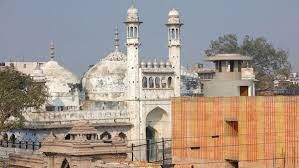Gyanvapi Mosque Survey Report:

The Archaeological Survey of India (ASI) submitted its survey report of the Gyanvapi mosque complex in Varanasi to the district court in December 2022.
- The report concludes that remains of an old Hindu temple existed at the site before the construction of the current mosque structure during Aurangzeb’s reign in the 17th century.
- ASI used ground penetrating radar, differential global positioning systems and scientific dating methods for the survey.
- These advanced technologies provided evidence about underground structures without excavation, exact locations of artefacts and age of very old objects at the site.
- This finding aligns with Persian chronicles and accounts of historians over the years that a Hindu temple adjacent to the Kashi Vishwanath temple was demolished on Aurangzeb’s orders in the 17th century.
- The Persian text Maasir-i-Alamgiri written soon after Aurangzeb’s death in 1707 records his orders in 1669 to governors across India to destroy Hindu temples.
- This included the razing of the Vishwanath temple in Kashi. Historian Jadunath Sarkar’s translation of this text formed key evidence for the ASI report.
- Gyanvapi mosque was constructed in the 1670s or 1680s, incorporating parts of the destroyed Vishwanath temple’s wall.
- This reuse of materials may have been an assertion of Mughal power after Hindu rebels were assisted by local elements.
- While the Gyanvapi mosque was built on the ruins of the old Vishwanath temple, the current Kashi Vishwanath temple near it was built in the 18th century.
- The history of temple desecration but persistent rebuilding reflects the enduring public belief in the religious significance of the site.




